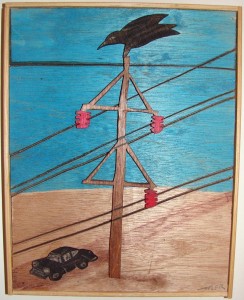I bought a piece of Jack’s art called “Crow on Pole I”, after I watched him hang the show at the Vertin Gallery in Calumet Michigan, where I spent five days as a resident artist. The piece pictured here isn’t much bigger than a sheet of paper, but I find the perspective–a crow looking down from a telephone pole on a passing car–irresistible.
Crows make frequent appearances in Jack Oyler’s work, which consists of flat wooden shapes cut, painted and glued to a larger flat wooden piece. The finished work looks simultaneously two- and three-dimensional to me, and the frequent appearance of crows, which might once have felt ominous, are taking on another dimension. Good art, I believe, changes how one sees, and Jack Oyler is changing the way I see crows.
So I ask myself, as I always do when I invest in a person or a work of art, what’s the attraction? At first I wondered if I might be feeling a bit morbid, but I don’t think so. Jack’s crows inspire in me, instead of dread, a sense of play. I could watch him work on the floor below my temporary quarters in Calumet’s Vertin Gallery and he was having too much fun, it seems to me, to inspire anything but delight. No wonder he’s punned his new show “This Superior Life.”
Not all Jack’s work involves crows. “It’s about the everyday stuff I see,” he says: “Crows, dogs, cars, trees, girls, Cirque du Solei.” The crows are my favorite, providing interesting silhouettes and instant contrast to what Jack calls his “elaborate stories” and what I call his uncomplicated compositions. In an interview published for the show, Jack claims that he adds pieces “until the plane is full”, and then he takes things out “until the painting is as simple as possible.”
I find Jack Oyler’s images simple and strong, inviting metaphor, sly humor shining through. I’ve decided that my crow–the one on the pole watching me pass by below–is my incorrigible shadow flying circles around me, winging ahead and waiting for me to catch up, as I progress, despite everything, along my own superior life.

